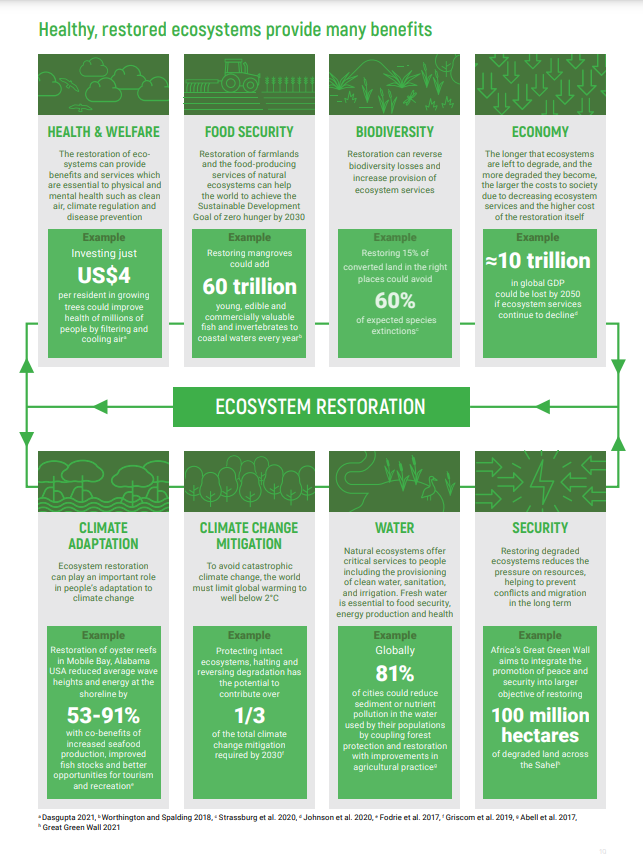The Crisis of Desertification, Land Degradation and Drought, and the Importance of Land Restoration
Desertification, land degradation, and drought (DLDD) are a silent and invisible crisis that affects people and the planet. As human life requires fertile and productive lands for many essential activities, desertification represents an important obstacle to sustainable development and an aggravator of poverty, poor health, lack of food security, biodiversity loss, water scarcity, forced migration, and lowered resilience to climate change or natural disasters. Estimates indicate that human-induced land degradation affects at least 1.6 billion hectares worldwide, directly affecting 3.2 billion people.
While desertification impacts mostly dryland areas, droughts have become a common event in many areas of the world. The ntergovernmental Panel on Climate Change (IPCC) finds medium confidence that agricultural and ecological droughts have increased in several regions on all continents, with variable certainty of human-induced climate change impact on these changes (Chapter 11 of the IPCC AR6 of Working Group 1 – 2021).
As the triple planetary crisis of climate change, biodiversity loss, and pollution and waste impact the health of land it is essential to halt human activities that lead to land degradation and work towards restoring land to protect livelihoods, climate, and biodiversity. According to the United Nations Convention to Combat Desertification (UNCCD), restoring degraded land globally could lock away three billion tonnes of atmospheric carbon into the soil every year, supporting the achievement of the 1.5° target. Land restoration is also essential to ensure human rights, sustainable development, food security, employment, disaster risk reduction, ecological benefits, and improved public health.
Desertification
Desertification is defined as land degradation in arid, semi-arid, and dry sub-humid areas resulting from various factors, mostly climatic variations and human activities (UNCCD, 1994). Although the term can include the encroachment of sand dunes on land, it does not refer to the expansion of existing deserts. It occurs, however, because dryland ecosystems, which cover over one-third of the world’s land area, are extremely vulnerable to overexploitation and inappropriate land use. In the past decades, the range and intensity of desertification have increased, reaching approximately 30 to 35 times the historical rate and the risks from desertification are projected to increase due to climate change (IPCC, 2019). While being a hard process to quantify, desertification is characterized by declining vegetation productivity, reduced agricultural productivity and biodiversity loss (IPCC, 2019).
According to the IPCC, the major human drivers of desertification interacting with climate change are the expansion of croplands, unsustainable land management practices and increased pressure on land from population and income growth. On the other hand, desertification exacerbates climate change through several mechanisms such as changes in vegetation cover, sand and dust aerosols and greenhouse gas fluxes.
Drought
Meteorologically, drought is defined as a prolonged absence or marked deficiency of precipitation that can be characterized as a period of abnormally dry weather with a sufficiently prolonged lack of precipitation as to cause a serious hydrological imbalance (WMO, 1992). Other definitions include impacts like hydrological imbalances that adversely affect land resource productions systems (UNCCD, 1994; Article 1). Put into other words, drought is a climatic phenomenon that can occur almost anywhere in the world when there is a significant decrease in water availability (atmospheric, surface, soil, or groundwater) over a period of weeks to years. Climate change is increasing the frequencies and/or magnitudes of droughts in many regions of the world (IPCC, 2021).
Droughts are among the greatest threats to sustainable development, especially in developing countries, but increasingly so in developed nations too. In fact, forecasts estimate that by 2050 droughts may affect over three-quarters of the world’s population.The number and duration of droughts has increased by 29 percent since 2000, as compared to the two previous decades (WMO 2021). When more than 2.3 billion people already face water stress, this is a huge problem.
The UN Convention to Combat Desertification’s 2022 report Droughts in Numbers finds that the African continent has been the most impacted by droughts in the past century, with over 300 episodes and bearing an important death and economic toll around the world. Projections indicate that by 2050, droughts may affect over three-quarters of the world’s population, and an estimated 4.8-5.7 billion people will live in areas that are water-scarce for at least one month each year, up from 3.6 billion today. Up to 216 million people could be forced to migrate by 2050, largely due to drought in combination with other factors including water scarcity, declining crop productivity, sea-level rise, and overpopulation.
Land Degradation and Restoration
The Intergovernmental Science-Policy Platform on Biodiversity and Ecosystem Services (IPBES) defines land degradation as “the many human-caused processes that drive the decline or loss in biodiversity, ecosystem functions or ecosystem services in any terrestrial and associated aquatic ecosystems”, and restoration as “any intentional activity that initiates or accelerates the recovery of an ecosystem from a degraded state”. Land degradation affects ecosystem functions worldwide disrupts rainfall patterns, exacerbates extreme weather like droughts or floods, and drives further climate change and it is connected with instability, which drives poverty, conflict, and migration.
On the other hand, land restoration is the ecological process of restoring a natural and safe landscape for humans, wildlife, and plant communities (UNCCD). Through land restoration, it is possible to reinstate the land’s function to store carbon, to prevent droughts and floods and increase soil productivity. Land restoration can bring economic benefits amounting to USD 30 for every dollar invested in restoration (UNEP, 2021). Restoration boosts livelihoods, lowers poverty and builds resilience to extreme weather. Restoration increases carbon storage and slows climate change. Restoring just 15 per cent of land and halting further conversation could avoid up to 60 per cent of expected species extinctions.

